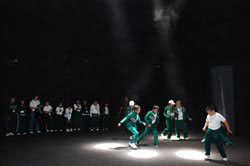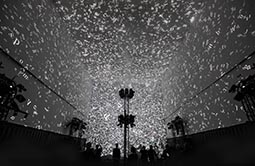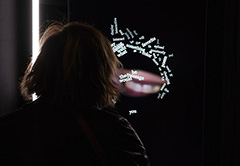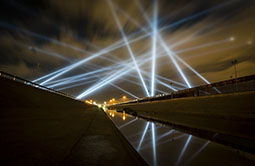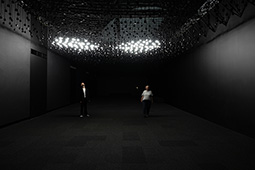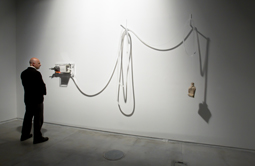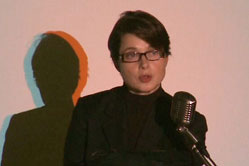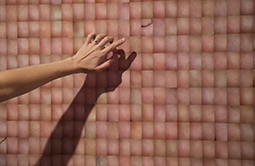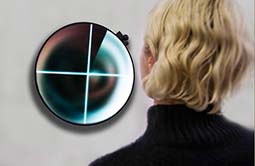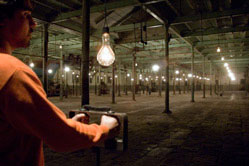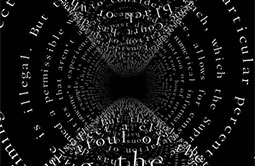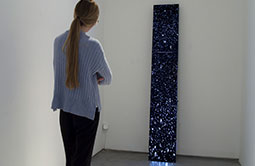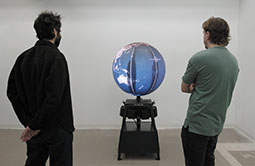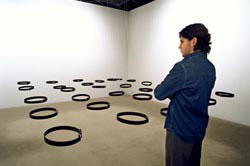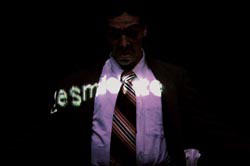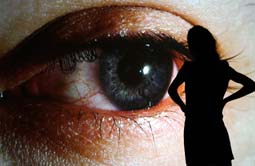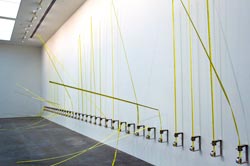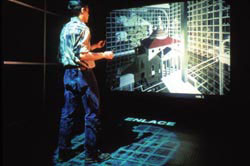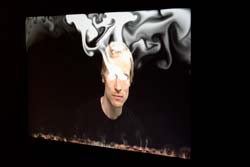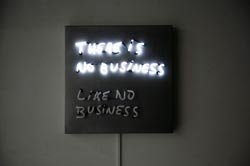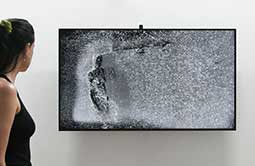1000 Platitudes
2003
"1000 Platitudes" is a large-scale photographic intervention project. It is comprised of photomontages and a video with 1,000 words or expressions commonly used to promote globalized cities to potential investors, such as "open", "modern", "clean", "multicultural" and "cosmopolitan". To make these images, a powerful projector (110,000 ANSI lumens of intensity for images of up to 70 by 70 metres) was placed on a 12-ton truck with a generator, then toured across the city of Linz, Austria.
View details.
View details.
1984x1984
Shadow Box 10, 2014
"1984x1984" (Shadow Box 10) is the tenth piece in Lozano-Hemmer’s Shadow Box series of interactive displays with a built-in computerized tracking system. The piece shows a grid of thousands of random numbers extracted from addresses photographed by Google Street View. Scanned by Google from the front doors of buildings around the world, the numbers have an immense variety of fonts, colours, textures, and styles. As a viewer walks in front of the piece, their silhouette is represented within the display, and within its form, all the numbers count down to show the number 1984 repeated throughout. The piece was made as a homage to George Orwell’s eponymous dystopian novel, 30 years after his predicted date for the collapse of privacy.
View details.
View details.
33 Questions per Minute
Relational Architecture 5, 2000
"33 Questions Per Minute" (Relational Architecture 5) consists of a computer program which uses grammatical rules to combine words from a dictionary and generate 4.7 trillion unique, fortuitous questions. The automated questions are presented at a rate of 33 per minute—the threshold of legibility. The system will take over 271,000 years to ask all possible questions.
View details.
View details.
A Crack in the Hourglass
2020
“A Crack in the Hourglass” is a transitory “anti-monument” in response to the pandemic and the ways it has halted public rituals of mourning. In this participatory artwork, a modified robotic plotter deposits grains of hourglass sand onto a black surface to recreate the images of those lost due to COVID-19.
View details.
View details.
Airborne Series
Shadow Box 11, 2015
“Airborne Series” (Shadow Box 11) is a set of interactive installations designed to animate literary, scientific, and philosophical texts on the subjects of entropy, complexity, chance and non-linear dynamics. As a viewer stands in front of the work a sensor creates a "heat map" of his or her body and evaporates letters of the text that scroll on screen and which become "airborne", generating turbulent movements. As the participant moves away the letters cool down and precipitate. The interaction fills the screen slowly, showing tens of thousands of letters, at which point the text fades out, and begins to scroll again from the beginning.
View details.
View details.
All the Waters
2022
“All the Waters” is an installation consisting of a robot arm that constantly writes calligraphy on a sheet of heated corten steel. A Japanese brush collects water from a fold on the steel plate and draws new words at the rate that previous ones evaporate, similar to the ephemeral-drawing artworks such as “Re/trato” by Oscar Muñoz. The words written by the piece are over 2,000 brand names for bottled water from around the world, which feature banal, geographic, religious or environmental names: Aguavita, Polar Spring, Belles Roches, Santa Vittoria, AxyZen, Pure Life, BoNatura and so on.
View details.
View details.
Alpha Blend
Shadow Box 7, 2008
"Alpha Blend" (Shadow Box 7) is an interactive display with a built-in computerized tracking system that show the viewer's presence, revealing and blending pictures of people who have previously looked at the work. A game of "reverse puppetry" ensues, where a portrait from the past is animated by a live presence, in a similar perceptual mechanism than the one used in Lozano-Hemmer's public art installation "Body Movies" (2001).
View details.
View details.
Apostasis
2008
An interactive installation featuring powerful robotic searchlights that create static columns of light in a dark room. When someone tries to walk into a light beam, a computer automatically moves the searchlight so that the beam is pointed somewhere else on the room. A video tracking system observes the room and makes sure that the lights are always illuminating empty spaces where there is no one. People may continually attempt to enter the spotlight but the system will adapt to ensure this can never be achieved.
View details.
View details.
Autopoiesis
2010
When people look at themselves in this small mirror they see the word "Autopoiesis" projected on their forehead. The concept of self-creation described by Chilean biologists Maturana and Varela is an inspiration for all art that depends on participation to exist.
View details.
View details.
Babbage Lovelace
Text Stream 5, 2019
“Babbage Lovelace” (Text Stream 5) is a generative animation based on the collected texts of Charles Babbage and Ada Lovelace turned into a stream of letters.
View details.
View details.
Babbage Nanopamphlets
2015
Two million pamphlets were printed in elemental gold, higher in purity than 24-karat gold, using nanotechnology techniques. Around 250,000 copies were released in the exhibition room so they remain floating around in the air, potentially inhaled by the public. These pamphlets are 150 atoms thick and are biologically inert so pose no health risk. The rest of the pamphlets are shown suspended in water together with images taken by an electron microscope. The text engraved onto the gold leaflets is an excerpt from the Ninth Bridgewater Treatise (1837) by Charles Babbage. The text posits that the atmosphere is a vast repository of everything that has ever been said and that we could potentially "rewind" the movement of every molecule of air to recreate the voices of everyone who has spoken in the past.
View details.
View details.
Banderoles
2021
Influenced by works such as Samuel Beckett’s theatre production made teleplay “Not I” (1972; 1975) and “Messa di Voce” performed by Golan Levin and Zach Lieberman with vocalist-composers Jaap Block and Joan La Babara (2003-2005), “Banderoles” continues the performative tradition of harnessing the visual power of the mouth and visualizing the human voice.
“Banderoles” uses voice and face recognition to capture an image of participants’ mouths and to create visual representations of the words being spoken.
View details.
View details.
Bifurcation
Shadow Object 2, 2012
“ Bifurcation” (Shadow Object 2) is small Y-shaped branch, similar to a divining rod, which is suspended from a thread and moves with the air flow and with a small motor. Projected on the wall behind the branch is its shadow, only you can see the entire tree from where the branch came. The branch and the tree shadow are always oriented in the same way.
View details.
View details.
Bilateral Time Slicer
2016
“Bilateral Time Slicer” is a biometric tracking system that finds the axis of symmetry of members of the public and splits a live camera image into two slices. With each new participant time slices are recorded and pushed aside. When no one is viewing the work, the slices close and rejoin creating a procession of past recordings.
View details.
View details.
Binocular Tension
2024
“Binocular Tension” is a light box showing two human eyes that track and follow the observer with a built-in computerized tracking system. When a member of the public is detected, their presence triggers the eyes to wake up, looking at the visitor directly, creating an uncanny experience that questions who is the observer and who is the observed. Over 1,500 photographs were used to create this interactive stop-motion artwork. The piece is part of a series on surveillance that started in 1992 with “Surface Tension,” which shows a giant human eye following the observer with Orwellian precision. In this series of works, the artist creates a tangible manifestation of observation as the subject of the work of art. Here, eye contact is presented as a technological mechanism of sentience, seduction, policing, and control.
View details.
View details.
Blow Up
Shadow Box 4, 2007
"Blow-up" (Shadow Box 4) is an interactive piece designed to fragment a surveillance camera view into 2400 virtual cameras that zoom into the exhibition space in a fluid and autonomous motion. Inspired by 20th-century Italian filmmaker Michelangelo Antonioni, the piece is intended as an exercise to underline the construction of presence through a simulated, live compound eye.
View details.
View details.
Blue Sun
2018
Blue Sun is a spherical chandelier that represents the turbulence, flares, and spots visible on the surface of the sun using the hottest colours in the spectrum: blue and white. Animated by mathematical equations and the latest imagery from NASA’s solar observatories, the content is dynamic and ever-changing, based on live rather than looped video simulations. The piece draws equal inspiration from scientific visualization and traditions of geometric abstraction in contemporary art.
View details.
View details.
Border Tuner / Sintonizador Fronterizo
Relational Architecture 23, 2019
"Border Tuner" is a large-scale, participatory art installation designed to interconnect the cities of El Paso, Texas, and Ciudad Juárez, Chihuahua. Powerful searchlights make “bridges of light” that open live sound channels for communication across the US-Mexico border. The piece creates a fluid canopy of light that can be modified by visitors to six interactive stations, three placed in El Paso and three in Juárez.
View details.
View details.
Botella de Castigos
2022
“Botella de Castigos” is an artwork where thousands of bottles are presented spinning slowly on a display, creating a clock that counts 59 seconds per minute. The bottles come from popular and elite “brands” of water from all over the world, as well as AI generated bottles of brands that do not exist.
View details.
View details.
Call on Water
2016
Call on Water is a fountain that writes words in mid-air with plumes of cold vapour that ascend from a water basin. Dozens of poems by Mexican writer Octavio Paz are presented which describe readable air, the moment when the written word is spoken and becomes the atmosphere itself. The poems’ content becomes tangible briefly, almost breathable, then disappears in turbulence.
View details.
View details.
Cardinal Directions
Subsculpture 11, 2010
"Cardinal Directions", is a kinetic sculpture which consists of a surveillance monitor that displays an extract of Vicente Huidobro´s poem "Altazor" (1919-1931). Refering to the geography of his native Chile, Huidobro wrote "The four cardinal directions are three: North and South". When a presence is detected by infrared sensors, the monitor starts to rotate. As the poem is "geolocated" it always aligns itself to the cardinal points, and the public must walk around the piece in order to read it, like a kind of periscope.
View details.
View details.
Close-up
Shadow Box 3, 2006
"Close-up", the third piece of the Shadow Box series, is an interactive piece in which a participant's silhouette reveals hundreds of tiny videos of other people who have previously looked at the work. When a viewer approaches the piece, the system automatically starts recording and makes a video of him or her. Simultaneously, inside the viewer's silhouette, videos are triggered, showing up to 800 recent recordings. This piece presents a schizoid experience where one’s presence triggers a massive array of surveillance videos.
View details.
View details.
Cloud Display
2019
“Cloud Display” is a vertical water fountain consisting of 1,600 ultrasonic atomizers, controlled by a machine-learning voice recognition system. When a participant speaks into an intercom, the piece writes any words or sentences spoken using wisps of pure water vapour. The project can work in most languages, and recognizes different accents.
View details.
View details.
Colorimètre
2017
A permanent comission for Maison Manuvie building in Montreal. The piece consists of 500 colour panels arranged in a grid. The piece features a surveillance system that does not track people, but rather saturated colors that may be present in the atrium. When a saturated colour is detected, the camera automatically zooms and tracks it so the atrium itself adopt the colour.
View details.
View details.
Descending a Parametric Staircase
2018
This piece is a generative animation showing a descent into a never-ending spiral staircase. From time to time, uncanny virtual naked people can be seen walking down the staircase. The work never repeats the same sequence of characters. “Descending a Parametric Staircase” is a homage to Duchamp’s futurist composite “Nude Descending a Staircase” from 1912, taking its colour palette, and his “Rotoreliefs” from 1935.
View details.
View details.
Double
Text Stream 4, 2018
“Double” (Text Stream 4) is a generative turbulent animation of the letters AGTC, representing DNA base pairs. At a given time, the piece shows the entire genetic code of the Haemophilus Influenzae bacterium, the first organism to have its genome sequenced, in 1995, with 1.8 million base pairs. Periodically, the display switches to show the artist’s own entire genetic code, featuring 3.2 billion base pairs.
View details.
View details.
EXCUSE YOU!
2022
A collaboration with poet Leigh Kotsilidis, "EXCUSE YOU!" is an indignant yet playful neon sign. A timely calling out. An affable chastising. A snarky apology on your behalf. A provocation for self-reflection. A chance for absolution. EXCUSE YOU! is the figurative finger pointing at all of us, saying: own and apologize for your shit because it's about time!
View details.
View details.
Encode/Decode
2020
"Encode/Decode," a generative interactive typographical environment made from the critical essay of Jamaican-British cultural studies scholar Stuart Hall (1932-2014) in which he proposes an encoding/decoding model of communication.
View details.
View details.
Entanglement
Subsculpture 6, 2005
"Entanglement" (Subsculpture 6) is an interactive installation that consists of two identical neon signs, each measuring 182 x 38 cm. The signs simply state the word "Entanglement", a term used in quantum physics to describe the strange property exhibited by two particles that behave as one. The two signs are connected and do not work independently, turning on and off together by way of a basic light switch, even if the entangled pair is in different cities and in separate rooms.
View details.
View details.
External Interior
2015
"External Interior" is an inside-out disco ball made with 1600 one-way mirrors mounted on a transparent acrylic sphere, reminiscent of both Julio Le Parc’s mirrored sculptures and the tessellated vision present in insects with compound eyes. The piece is suspended from pulleys and has a counterweight so that it can be raised and lowered easily. As visitors introduce their head inside the sphere, they see a mise en abyme reflection multiplied kaleidoscopically, creating both a spacious, yet isolated, self-centered experience. Meanwhile, from the outside, the public can clearly see the person inside the sphere.
View details.
View details.
Eye Contact
Shadow Box 1, 2006
"Eye Contact" (Shadow Box 1) is the first piece of the Shadow Box series of interactive displays with a built-in computerized tracking system. This piece shows eight hundred simultaneous videos of people lying down, resting. As soon as a public member is detected, his or her presence triggers the miniature video portraits to wake up: hundreds of people simultaneously turn to look at the visitor directly, creating an uncanny experience that questions who is the observer and who is the observed.
View details.
View details.
Field Atmosphonia
2020
“Field Atmosphonia” is a sound and light environment featuring 3,000 audio channels playing on custom-made speakers with LED lights. The project is a soundscape that comes in waves of complex polyphonies that emerge from the array of field recordings.
View details.
View details.
First Surface
Shadow Object 3, 2012
“First Surface” (Shadow Object 3) is an artwork consisting of two front surface mirrors that are suspended from a thread and move with the air flow and with a small motor. Projected on the wall behind the mirrors is a real-time virtual representation of the public as seen from the perspective of the mirrors. The public is represented as patterned 3D silhouettes anchored in a reference prism that rotates with the mirrors. The piece is an attempt to construct an artificial perspective on the reflected subject.
View details.
View details.
Flatsun
2011
“Flatsun” is a circular display that simulates the turbulence at the surface of the Sun using mathematical equations. The piece reacts to the presence of the public by varying the speed and type of animation displayed. If no one is in front of the piece the turbulence slows down and eventually turns off. As the built-in camera detects people, more solar flares are generated and the fake Sun shows more perturbation and activity. At 140 cm diameter, “Flatsun” is exactly a billion times smaller than the real Sun.
View details.
View details.
Frequency and Volume
Relational Architecture 9, 2003
"Frequency and Volume" (Relational Architecture 9) enables participants to tune into and listen to different radio frequencies by using their own bodies. A computerized tracking system detects participants' shadows, which are projected on a wall of the exhibition space. The shadows scan radio waves with their presence and position, while their size controls the volume of the signal. The piece can tune into any frequency between 150 kHz and 1.5 GHz, including air traffic control, FM, AM, short wave, cellular, CB, satellite, wireless telecommunication systems and radio navigation. Up to forty-eight frequencies can be tuned simultaneously and the resulting sound environment forms a composition controlled by people's movements.
View details.
View details.
Glories of Accounting
Subsculpture 5, 2005
"Glories of Accounting" (Subsculpture 5) is an interactive installation with a surveillance system that detects the position of the public in the exhibition room. When someone walks into the room, large hands appear on the screen automatically. The hands rotate along their forearm axis, following the visitor with the open palms always facing them. As more viewers enter the room, more hands appear, each one following a member of the public.
View details.
View details.
Homographies
Subsculpture 7, 2006
"Homographies" (Subsculpture 7) is a large-scale interactive installation featuring a turbulent light array that responds to the movement of the public using a surveillance tracking system. The installation consists of white fluorescent light tubes hung from robotic fixtures on the ceiling of the exhibition space, equally spaced. Each light tube rotates slowly using a computerized stepper motor and create labyrinthine patterns of light that make "paths" or "corridors" between people. All lights are always on and typically constitute the only lighting in the exhibition hall, except for the natural light that spills into the space.
View details.
View details.
Hormonium
Text Stream 8, 2022
“Hormonium” (Text Stream 8) is a generative artwork that presents sequences of ocean waves crashing and releasing airborne text particles, with the text representing acronyms of hormones that are released in accordance with human time-cycles. This artwork is available as both a projection and a standalone piece.
View details.
View details.
Inspired by Real Events
2004
"Inspired by Real Events" is a series of six black and white photos taken from the point of view of surveillance cameras in different public places of Mexico City. Each photo shows a volunteer climbing a ladder about to reach the camera with his or her hand. A video on a surveillance monitor shows the sequences captured by the cameras.
View details.
View details.
Kristallstimmen
2024
An interactive installation for Swarovski’s “Crystal Worlds Museum” in Wattens, Austria, features an array of 3,000 suspended loudspeakers, each clad in hundreds of small black crystals that get illuminated when in use. As visitors traverse the space, sensors detect their presence and turn on the speaker directly above them, which lights up and plays a voice message. Each loudspeaker contains a recording from a different company employee from around the world, speaking in their native language about their relationship to crystal, with over 100 languages represented. When no visitor is present, the installation is silent.
View details.
View details.
Last Breath
2012
“Last Breath” is an installation designed to store and circulate the breath of a person forever. The piece consists of a small brown paper bag which inflates and deflates automatically thanks to motorized bellows similar to those found in artificial respirators in hospitals. The apparatus hangs on a wall and is activated 10,000 times a day, the typical respiratory frequency for an adult at rest, including 158 sighs.
View details.
View details.
Less Than Three
2008
"Less than Three" is an interactive installation of light strips that form a network between two intercoms. As a participant speaks into an intercom, their voice is translated into corresponding flashes of light and this light pattern is transmitted visually along one of the several possible pathways through the network. When it reaches the other side, the viewer's phrase is once again released as sound. Several voices can be carried simultaneously and the short contributions going fast through the network and the longer ones taking longer.
View details.
View details.
Level of Confidence
2015
"Level of Confidence" is a face-recognition camera that has been trained with the faces of the 43 disappeared students from Ayotzinapa school in Iguala, Mexico. As you stand in front of the camera, the system uses algorithms to find which student's facial features look most like yours and gives a "level of confidence" on how accurate the match is, in percent. The piece will always fail to make a positive match, as we know that the students were likely murdered, but the commemorative side of the project is the relentless search for them and their overlap with the public's own facial features. The project software is available for free download so that any university, cultural centre, gallery or institution can set-up the piece. In addition, if the project is acquired by collectors, all proceeds will go to the affected community, in the form of scholarships for example.
View details.
View details.
Levels of Nothingness
Performers 1, 2009
"Levels of Nothingness" is an installation-performance commissioned for the 50th Anniversary of the Guggenheim Museum, inspired by Kandinsky's opera, "The Yellow Sound" (1912). In "Levels of Nothingness", the human voice is analyzed by computers, automatically controlling a full rig of Rock-and-Roll concert lighting and creating an interactive colour show. For the New York performances, Isabella Rossellini read a libretto co-written by Brian Massumi, which included seminal philosophical texts on skepticism, color and perception, including writings by Kandinsky, Deleuze, Sanches, Simon Baron-Cohen and Alexander Luria. Following the performances, audience members could test the color-generating microphone.
View details.
View details.
Linear Atmosphonia
2019
“Linear Atmosphonia” is a sound environment featuring 3,000 audio channels playing on separate custom-made speakers with LED lights. The piece can be presented as a tunnel or room, and the recordings change typology gradually along the field of speakers: recordings include wind, water, fire, ice, over 200 types of insects, over 300 types of birds, bells, metronomes, bombs and so on. The project results in waves of complex polyphonies that emerge from the array of field recordings.
View details.
View details.
Make Out
Shadow Box 8, 2008
"Make Out" (Shadow Box 8) is an interactive piece showing thousands of internet videos of couples looking at each other. As soon as a participant stands in front of the display his or her silhouette is shown and all the couples within it begin to kiss. The massive array of make-out sessions continues for as long as someone is in front of the work—as he or she moves away all the kissing ends.
View details.
View details.
Method Random
2014
"Method Random" is a series of chromogenic prints generated by computational methods attempting to create randomness. Random number generators(RNG) are essential algorithms for a large number of applications, from encryption and security to simulation, jury selection, double-blind trials, statistical sampling, game theory and many others. While the sum of all colours picked by different RNG algorithms generates a neutral gray, a pattern can be discerned when a massive number of pixels can be seen simultaneously. These prints show how human perception of an organization can often spot the fundamental difficulty for computers to appear unpredictable.
View details.
View details.
Metrónomos
2018
“Metrónomos” is a kinetic installation consisting of eight inverted nooses, which move slightly according to the rhythm of various global statistics on human rights violations. Commissioned for Mexico’s Memory and Tolerance Museum, the sculptures are presented on pedestals, arranged in a semi-circle. The frequency in which each noose, or metronome, sways depends on the statistic that each one represents: the number of forced displacements or deportations, acts of torture, cruelty and sexual violence, crimes against the environment, among others. Each noose contains the heartbreaking rhythm of a different scale, in order to materialize, symbolically, the frequency in which human rights are violated. Together, they create a chorus of sculptures activated by statistical data.
View details.
View details.
Microphones
Subsculpture 10, 2008
"Microphones" (Subsculpture 10) is an interactive installation featuring one or several 1939-vintage Shure microphones, placed on mic stands around the exhibition room at different heights. Each microphone has been modified so that inside its head is a tiny loudspeaker and a circuit board connected to a network of hidden control computers. When a public member speaks into a microphone, it records his or her voice and immediately plays back the voice of a previous participant, as an echo from the past.
View details.
View details.
Nave Solar
2011
“Nave Solar” is an interactive installation featuring a fake Sun that is activated by the pendular motion of the public as they hang from a rope and swing along the nave of a 16th Century catholic inquisition church. Using tracking systems, the installation detects the motion of participants and generates smoke that accumulates on the ceiling of the apse as well as activates the Sun's flares, surface turbulence and sun spots.
View details.
View details.
Navier-Stokes
2009
"Navier-Stokes" is a series of computer-controlled lightboxes that show satellite pictures of border regions that have a vector of economic disparity, a history of military conflict or heavy migratory traffic. Instead of using regular white fluorescent light tubes to illuminate the print, the pieces have over one hundred thousand light emitting diodes (LEDs), which can highlight tiny features within the image. The first piece shows the Tijuana-San Diego border with Mexico illuminated red by default while the US is dark.
View details.
View details.
Nineteen Eighty-Four
2014
"Nineteen Eighty-Four" is an interactive display that shows house address numbers extracted from Google Street View images. The display writes over 22 billion different combinations of the number 1984, which change at a user-specified speed. Typing any number onto an onboard keyboard starts a count-down or count-up until eventually the number 1984 is reached.
View details.
View details.
Nothing is More Optimistic than Stjärnsund
2010
“Nothing is More Optimistic than Stjärnsund” consists of twenty modified padlocks which can be interconnected to create chains or assemblages, as the collector or curator sees fit. The piece is intended as a construction kit with a plethora of possible combinations, like a Meccanno, and is a hommage to Lygia Clark's "Relational Objects”.
View details.
View details.
Pan-Anthem
Subsculpture 16, 2014
"Pan-Anthem" (Subsculpture 16) is an interactive sound installation where the national anthem of every country in the World plays back on a movable speaker that is magnetically attached to a large wall. The speakers are precisely arranged to visualize national statistics: population, GDP, area, number of women in parliament, GINI, year of independence, HDI and so on.
For example, when the work is configured to show military spending per capita, on the far left of the wall the public can hear the anthems of countries without military forces like Costa Rica, Iceland and Andorra while at the far right they can hear Saudi Arabia, Israel and the United States, which spend more than $2,000 per person per year. If no one is in the exhibition room all the speakers are silent, but as a visitor approaches a particular set of speakers these start playing automatically, creating a positional panoramic playback of anthems associated to similar statistics.
View details.
View details.
Pareidolium
2018
“Pareidolium” is a circular fountain that creates portraits of onlookers in mid-air with clouds of vapor that ascend from the water basin. As a visitor looks into the water, a facial-detection system extracts their image and creates an ephemeral likeness in cold vapour. The portrait becomes tangible, almost breathable, only briefly, then disappears in turbulence.
View details.
View details.
Password Breach
2021
In “Password Breach,” all the passwords extracted from salient historical data breaches are presented as an additive smear on 77 small electronic-paper displays which synchronize and reset intermittently. The breaches include the Panama Papers, Ashley Madison, and RockYou2021.
View details.
View details.
People on People
2010
“People on People” is an installation designed to displace the public’s image in real-time, creating a platform for embodiment and interpenetration. The piece consists of floor-mounted projectors that cast the shadow of the public onto a wall and another set of hanging projectors which project images inside the shadows.
View details.
View details.
Performance Review
2013
“Performance Review” is a photographic project comprised of thousands of fingerprints captured by high-magnification digital surveillance equipment. While the distinctive patterns found in friction ridges of the human finger allow for the identification of an individual, in these images those singularities are subsumed to create an ambiguous image, representing the generalized use of biometry itself. Named after 15 banks, the c-prints in this series are unique, each consisting of fingerprints from 750 different people.
View details.
View details.
Pinches Pelos
2009
“Pinches Pelos” is artwork consisting of human hairs engraved using a nanotechnology technique known as "Focused Ion Beam" (FIB). Each hair was coated with a gold film, FIB engraved with words and photographed with an electron microscope. The piece consists of a metal frame that holds the hair inside a test-tube, a backlit transparency and a certificate from the Brockhouse Institute for Materials Research..
View details.
View details.
Please Empty Your Pockets
Subsculpture 12, 2010
“Please Empty your Pockets” (Subsculpture 12) is an installation that consists of a conveyor belt with a scanner that records and accumulates everything that passes under it. The public may place any small object on the conveyor belt: once it passes under the scanner, the object reappears on the other side beside projected objects from the memory of the installation. As a real item is removed from the conveyor belt, it leaves behind a projected image of itself, which is then used to accompany future objects. The piece remembers up to 600,000 objects which are displayed beside new ones that are added to the installation.
View details.
View details.
Polar
2018
A circular display that converts a camera’s cartesian grid of photo sensors into a representation in polar coordinates (an angle and a distance). The piece has a radar-like rotation mapped to the baseline of the live camera to add an element of time, emphasized by a quiet ticking sound. The polar distortion produces an anamorphic representation of people in front of the work, with all of them sharing the same origin.
View details.
View details.
Population Theatre
2016
"Population Theatre" is a scalable data-visualization theatre consisting of 7.5 billion individual computer-controlled points of light. The purpose of the piece is to create an experience that offers a one-to-one relationship between the world’s population and its data: every person is represented by a single point of light. "Population Theatre" is a platform for making data tangible, a direct representation of demographic data, and as such it can be used to create "data-dramatizations" that may help the public visualize data on political economy, cultural studies, sociology, anthropology, psychology, history, communications and other fields. People may stand on the stage and watch data performances, but they are also encouraged to walk along the corridors amongst the "rows" of monitors, physically "zooming-in" to see individual pixels, subverting the panoptic view and looking back at the public on the stage.
View details.
View details.
Pulse Index
2010
"Pulse Index" is an interactive installation that records participants’ fingerprints at the same time as their heart rates. The piece displays data for the last 765 and over participants in a stepped display that creates a horizon line of skin. As new recordings are added, the oldest ones disappear, —a kind of memento mori. To participate, people introduce their finger into a custom-made sensor equipped with a digital microscope and a heart rate sensor; their fingerprint immediately appears on the largest cell of the display, pulsating to their heart beat.
View details.
View details.
Pulse Phone
2009
“Pulse Phone” is an application that measures your heart rate by using the iPhone's built-in camera and flash. The application detects small variations in the opacity of your finger as blood flows through it and calculates your pulse in beats per minute using this information. The app visualizes the data graphically and can store it for later reference.
View details.
View details.
Pulse Room
2006
"Pulse Room" is an interactive installation featuring one to three hundred clear incandescent light bulbs, 300 W each and hung from a cable at a height of three metres. The bulbs are uniformly distributed over the exhibition room, filling it completely. An interface placed on a side of the room has a sensor that detects the heart rate of participants. When someone holds the interface, a computer detects his or her pulse and immediately sets off the closest bulb to flash at the exact rhythm of his or her heart.
View details.
View details.
Pulse Spiral
2008
"Pulse Spiral" is a three-dimensional spiral paraboloid made up of 400 lightbulbs arranged according to Fermat's equations, which records and responds to the heart rate of participants who hold a sensor underneath. Commissioned for the opening of the Center for Contemporary Culture in Moscow in the constructivist Bakhmetevsky Bus Garage, the piece is inspired by engineer Vladimir Shukov who worked with Melnikov on this emblematic building from 1926-28.
View details.
View details.
Pulse Tank
2008
"Pulse Tank" is an Interactive installation where the heart rates of members of the public are detected by sensors and converted into water waves in a ripple tank. A light show is created by the resulting waves and their interaction. To participate, insert your finger into one of the four cylinders on the side of the tank or put your hands flat on the front panel; the computer will detect your pulse and activate a solenoid which will hammer your heart rate onto the tank.
View details.
View details.
Pulse Voronoi
2024
One cubic metre of crystal explodes into 7,000 unique but complementary shards, expelled in all directions. "Pulse Voronoi" proposes a walk through the resulting cloud of crystals, shortly after the blast. The crystals are suspended in the room, each with a warm light that glimmers rhythmically to the recorded heartbeat of a different participant from the past. Five pulse sensors placed around the room detect visitors' heartbeats which can be heard in the room and seen in surrounding lights. Every new recording of vital signs deletes the oldest one, creating a memento mori.
View details.
View details.
Recognition
2018
"Recognition" is a machine-learning face recognition algorithm that classifies the viewer in relation to a constantly growing database of people who have seen the work in the past. This artwork is available as both a projection and a standalone piece.
View details.
View details.
Recurrent Anaximander
2020
“Recurrent Anaximander” is a generative animation running on a custom-made 400,000 pixel circular display. The piece features a solar simulation made with Reaction Diffusion, Navier Stokes, Voronoi and Perlin Noise algorithms, running on top of a Solar Dynamics Observatory (SDO) image that is updated daily by NASA.
View details.
View details.
Recurrent First Dream
Text Stream 10, 2022
“Recurrent First Dream” (Primero Sueño Recurrente) is a recursive algorithmic animation made with the collected works of Mexican poet Sor Juana Inés de la Cruz. An ascending vortex of words routinely appears and scans the displays, slowly revealing the poet’s mangum opus “First Dream”, a pioneering feminist ode to knowledge and deductive reasoning, written in 1692.
View details.
View details.
Recurrent Lloyd Wright
2024
“Recurrent Lloyd Wright” is a recursive algorithmic animation that draws together the vast corpus of Frank Lloyd Wright’s “Usonian” architectural blueprints and evaporates them into a fluid atmosphere. In this piece, the modernist utopian vision of Lloyd Wright’s designs drift back and forth, and are endlessly remade. The sense of context and materials at the core of the architect’s poetics is dissolved into a virtual and speculative existence. In rendering atmospheric Lloyd Wright’s grounded design, “Recurrent Lloyd Wright” is, at once, a commentary on the fate of modernism and a blueprint to imagine future, possible architectonics. This artwork is available as both a treatment and a standalone piece.
View details.
View details.
Recurrent Llull
Text Stream 7, 2019
“Recurrent Llull” (Text Stream 7) is a recursive algorithmic animation made with the collected works of Mediterranean philosopher and polymath Ramon Llull, born in the kingdom of Majorca in 1232. Among Llull’s accomplishments was the very first symbolic machine, a series of concentric circles that could be operated to generate combinations of “elemental truths”.
View details.
View details.
Recurrent Mallarmé
Text Stream 1, 2018
“Recurrent Mallarmé” (Text Stream 1) is a new algorithmic text spring made with the collected works of French poet Stéphane Mallarmé.“Recurrent Mallarmé” is a new algorithmic text spring made with the collected works of French poet Stéphane Mallarmé.
View details.
View details.
Recurrent Rayuela
Text Stream 6, 2020
"Recurrent Rayuela" (Text Stream 6) is a generative artwork made with the 155 chapters of the experimental novel "Rayuela" (Hopscotch) published in 1963 by Argentine writer Julio Cortázar. The piece consists of a black circular screen that shows a cube with thousands of letters from the book in a fluid, animated pool. When the screen is manually rotated by a visitor, the cube tumbles around and the letters become turbulent; after a few seconds, random excerpts from the novel emerge on screen from the turbulence. As soon as the rotation ends the excerpts disappear and the pool of letters stabilizes again.
View details.
View details.
Recurrent Sanches
Text Stream 3, 2018
“Recurrent Sanches” (Text Stream 3) is a new algorithmic text spring made with the works of Spanish-Portuguese philosopher and physician Francisco Sanches, most notably his sceptical treatise “That nothing can be known” Quod nihil scitur (1581) in which he proposes that nothing can be known through its causes, since it would also be necessary to know the causes of the causes, and then their causes, in an infinite regress.
View details.
View details.
Redundant Assembly
2015
In "Redundant Assembly," an arrangement of several cameras composes a live-portrait of the visitor from six perspectives simultaneously, aligned using face detection. The resulting image is uncanny, detached from the laws of symmetry and the depth perception of binocular vision. If several visitors are standing in front of the work, a composite portrait of their different facial features develops in real time, creating a mongrel "selfie".
View details.
View details.
Reference Flow
2009
"Reference Flow" is an interactive installation where a number of illuminated EXIT signs, supported by motorized stanchions, rotate automatically as people walk past them so that they always signal escape routes to the left. If several people stroll through the signs they get disoriented as they try their best to confront each person with his or her left.
View details.
View details.
Remote Pulse
2019
“Remote Pulse” is an interactive installation consisting of two identical pulse-sensing stations that are interconnected over the internet. When a person places their hands on one station automatically the person on the other station feels their pulse, as the plates vibrate in sync with the heartbeat of the remote person, and vice versa. The piece was originally presented as part of Lozano-Hemmer’s “Border Tuner” installation across the US-Mexico border.
View details.
View details.
Reporters With Borders
Shadow Box 6, 2007
"Reporters With Borders" (Shadow Box 6) is a high-resolution interactive display that simultaneously shows 864 video clips of news anchors taken from TV broadcasts in the United States and Mexico. As the viewer stands in front of the piece his or her silhouette is shown on the display and within it reporters begin to talk. Every 5 minutes the piece switches the video clips - from a database of 1600 - and classifies them along gender, race and country, so that for instance on the left there are only American reporters and on the right only Mexicans.
View details.
View details.
Seismoscopes
2009
The series "Seismoscopes" consists of devices that detect vibration around them, from footsteps to earthquakes, and record this vibration on paper using an automated XY-plotter. As each Seismoscope registers any seismic wave it is programmed to draw an illustration of a single Skeptical philosopher, over and over again.
View details.
View details.
Semioptics for Spinoza
Shadow Object 4, 2012
“Semioptics for Spinoza” (Shadow Object 4) is a plano-convex lens is suspended from a thread and moves with the airflow and with a small motor. Projected on the wall behind the lens is a set of artificial lens flares generated by equations that take into account the orientation of the lens in relation to the viewing public. The project generates fake light beams that go through the real lens: the lens then diffracts and scatters the fake light creating light source aberrations, directional haze and chromatic distortion.
View details.
View details.
Shadow Tuner
2023
An animated image of the Earth rotates on a sphere. As people approach and move around it, their movements are tracked and reflected on the sphere as black shadows. As shadows cover different cities, they automatically trigger live, local radio stations from those locations, thus creating a global polyphonic tuning device. This artwork is available as both an inflatable public sculpture and a standalone domestic piece.
View details.
View details.
Shadow Tuner - Standalone
2024
An animated image of the Earth rotates on a sphere. As people approach and move around it, their movements are tracked and reflected on the sphere as black shadows. As shadows cover different cities, they automatically trigger live, local radio stations from those locations, thus creating a global polyphonic tuning device. This artwork is available as both an inflatable public sculpture and a standalone domestic piece.
View details.
View details.
Sitestepper
Relational Architecture 10, 2004
"Sitestepper" (Relational Architecture 10) is an Internet program that shows a 3D view of an apparently "neutral" living room. This space can be transformed automatically by scanning a website to extract its images, texts, colours and sounds. The system analyzes the contents of the submitted webpage and uses them to furnish and decorate the room, "branding" the space with a layer of live media. This project was commissioned for LA MOCA's digital gallery.
View details.
View details.
Spectral Subjects
2024
“Spectral Subjects” is a thermal observatory, showing a constantly updating map of the room’s temperature on surround projections. Using thermographic cameras, the project detects heat and cold in the environment, including the building’s air circulation and ventilation, visitors’ body heat, and inanimate objects. The piece automatically mixes live feeds with recordings from the recent past, creating thermal echoes in the atmosphere, an evolving portrait of uncanny spectral traces that make the atmosphere tangible. This artwork is available as both a treatment and a standalone piece.
View details.
View details.
Sphere Packing
Subsculpture 15, 2013
"Sphere Packing" (Subsculpture 15) is a series of 3D-printed pieces designed to concentrate the entire musical production of a composer in a single dense multi-channel device. The size of each sphere is directly proportional to how prolific the composer was; for example the sphere for Hildegaard Von Bingen has an 11 cm diameter and 69 loudspeakers. The project presents at a glance the comparative production volume of many composers. As people are a couple of metres away from a sphere, they hear a quiet murmur of sounds, but as they approach and put their ears up close to individual speakers, they can hone in on specific compositions.
View details.
View details.
Sphere Packing: Bach
2018
A 3m diameter sphere that supports 1,128 loudspeakers each of which plays a different composition by Johann Sebastian Bach. The piece is designed to concentrate Bach’s entire musical production in a dense multi-channel structure that visitors can enter. At any given point, all compositions play-back simultaneously creating a polyvocal and complex sound environment focused in the centre of the sphere; from time to time the speakers are gradually silenced in waves to highlight one speaker playing a single composition.
View details.
View details.
Standards and Double Standards
Subsculpture 3, 2004
"Standards and Double Standards" (Subsculpture 3) is an interactive installation that consists of 10 to 100 fastened belts that are suspended at waist height from stepper motors on the ceiling of the exhibition room. Controlled by a computerized tracking system, the belts rotate automatically to follow the public, turning their buckles slowly to face passers-by. When several people are in the room their presence affects the entire group of belts, creating chaotic patterns of interference. Non-linear behaviours emerge such as turbulence, eddies and relatively quiet regions.
View details.
View details.
Subtitled Public
2005
"Subtitled Public" consists of an empty exhibition space where visitors are detected by a computerised surveillance system. When people enter the space, the system generates a subtitle for each person and projects it onto him or her: the subtitle is chosen at random from a list of all the verbs conjugated in the third person. The only way of getting rid of a subtitle is to touch another person, which leads to the two subtitles being exchanged.
View details.
View details.
Surface Tension
1992
"Surface Tension" is an interactive installation where an image of a giant human eye follows the observer with orwellian precision.This work was inspired by a reading of Georges Bataille's text The Solar Anus during the first Gulf War: first wide-spread deployment of camera-guided "intelligent bombs". Present-day computerised surveillance techniques employed by the Department of Homeland Security in the United States through the Patriot Act, provide a new and distressing backdrop for this piece.
View details.
View details.
Sustained Coincidence
Subsculpture 8, 2007
"Sustained Coincidence" (Subsculpture 8) is an interactive installation activated by the spatial relationships of visitors within a gallery. The piece consists of a series of incandescent lightbulbs that light up in reaction to the participants’ positions, in such a way that the shadows cast on the opposing wall are always overlapping. The piece is inspired by the phantasmagorias on the one hand and surveillance and digital analysis on the other.
View details.
View details.
Sway
2016
"Sway" is a kinetic sculpture that responds to data; it is a computer-controlled metronome that oscillates to the rhythm of a specific statistic. The rope was braided onto a thin vertical carbon fiber rod to make it stand upright and the floor rope acts as a free-standing base. The piece stands on a wooden plinth which contains a small motor and an electrical circuit that makes the noose sway and pendulate almost imperceptibly from time to time. The sway adds to the trompe l’oeil effect of the rope hanging upside-down. The collector or curator may choose the frequency with which the rope sways, with the default value being around once every 40 to 60 seconds, which represents therate of homicides in the World.
View details.
View details.
Synaptic Caguamas
Subsculpture 4, 2004
"Synaptic Caguamas" (Subsculpture 4) is a kinetic sculpture consisting of a motorized Mexican "cantina" bar table with 30 "Caguama"-sized beer bottles (1-litre each). The bottles spin on the table with patterns generated by cellular automata algorithms that simulate the neuronal connections in the brain. Every few minutes the bottles are reset automatically and seeded with new initial conditions for the algorithm, so that the movement patterns are never repeated.
View details.
View details.
Tape Recorders
Subsculpture 14, 2011
In “Tape Recorders” (Subsculpture 14), rows of motorised measuring tapes record the amount of time that visitors stay in the installation. As a computerised tracking system detects the presence of a person, the closest measuring tape starts to project upwards. When the tape reaches around 3 meters high it crashes and recoils back. Each hour, the system prints the total number of minutes spent by the sum of all visitors.
View details.
View details.
The Able Skin
1997
"The Able Skin" is a media structure designed by architect Emilio López-Galiacho to hide any emblematic building that is not allowed to have a natural death, that is kept alive artificially through restoration, citation and simulation. A virtual reality installation allows participants to tour the first Able Skin, which covers Palladios Villa Rotonda. The participant's motion controls the point of view in the projected environments on the wall and the floor.
View details.
View details.
The Company of Colours
Shadow Box 9, 2009
"The Company of Colours" (Shadow Box 9) is the ninth piece in the Shadow Box series of interactive displays with a built-in computerized tracking system. This piece shows the live camera view constructed out of a palette of named colour swatches that can be rendered by computers. Every few minutes the piece automatically switches to show the live view made with a variety of culturally-significant colour palettes from computer and video game history, including the four shades of green of the original Nintendo Gameboy, the eight colours of teletext, and the 16 colours of the Commodore 64, the Apple II and the ZX Spectrum.
View details.
View details.
The Trace
1995
"The Trace" is a telepresence installation that invites two participants in remote sites to share the same telematic space. The piece consists of light vectors, sounds and graphics that respond to the movement of the participants. Two interactive stations are needed for the piece; these are interconnected with a normal ISDN digital line so they can be in the same exhibition hall, on either side of a city or in different cities.
View details.
View details.
The Year's Midnight
Shadow Box 5, 2011
"The Year's Midnight" is an interactive installation that shows the viewers' image on screen, unprocessed, except for plumes of white or black smoke that emanate from their eye sockets until the whole display is filled with a dense smog. Live and recorded eyeballs extracted from the video accumulate on the bottom of the display, similar to traditional representations of St. Lucy. The project's name is the beginning of John Donne's "A Nocturnal Upon St. Lucy's Day, Being the Shortest Day", a mournful poem which inspires this work.
View details.
View details.
There Is No Business Like No Business
2009
“There is No Business Like No Business” is a blinking neon sign, designed during the recession as a cruel beacon of optimism. The blinking speed is directly proportional to the trading volume of any commodity index chosen by the collector or curator, say NASDAQ or Apple or FTSE100. In a slow day, or when the market is closed, the lines of illuminated text will only switch every 8 seconds, while on the busiest trading day they may blink every 2 seconds.
View details.
View details.
Thermal Drift
2022
“Thermal Drift” is an interactive artwork that visualizes the dispersion of body heat as emissions of thermal energy in the form of slow-moving packets or quanta that flow away from the participant. This artwork is available as both a projection and a standalone piece.
View details.
View details.
Thermal Drift Density Map
2022
“Thermal Drift Density Map” is an interactive artwork that visualizes the dispersion of body heat as emissions of thermal energy in the form of slow-moving packets or quanta that flow away from the participant. This artwork is available as both a projection and a standalone piece.
View details.
View details.
Thermal Poem
2022
A durational performance piece that consisted of a poem (by Leigh Kotsilidis) written on two naked bodies using ice-cold water. The writing was made visible by a live thermal camera projected onto the stage, and the words disappeared gradually as the bodies heated up the water.
View details.
View details.
Third Person
Shadow Box 2, 2006
"Third Person" (Shadow Box 2) is the second piece of the ShadowBox series of interactive displays with a built-in computerized tracking system. This piece shows the viewer's shadow revealing hundreds of tiny words that are in fact all the verbs of the dictionary conjugated in the third person. The portrait of the viewer is drawn in real time by active words, which appear automatically to fill his or her silhouette. The collector may choose to display the words in English, Spanish or French, or a combination of the three languages.
View details.
View details.
Transparency Display
2024
“Transparency Display” is an interactive glass triptych that reveals and conceals portraiture in real-time using the transparency and translucency of liquid crystal pixels embedded in glass panels. The piece automatically creates low-definition portraits of the viewers, which can be seen from either side of the triptych, regardless of the lighting conditions or time of day. Through these fleeting portraits a visitor on one side can see visitors on the other side, creating an uncanny and ever changing portal between them. Inspired by Dan Graham's reflective and refractive glass pavilions, Sharon Grace's digital pictures in picture, and Kit Galloway and Sherrie Rabinowitz's "Hole in the Wall" performance, the work converts an architectural subdivision into a connective switchboard for eye contact, shadow play, and sous- and surveillance.
View details.
View details.
Under Scan
Relational Architecture 11, 2005
"Under Scan" (Relational Architecture 11) is a public art installation based on self-representation. Thousands of "video-portraits" taken in Derby, Leicester, Lincoln, Northampton and Nottingham are projected onto the ground; at first, the portraits are not visible because the space is flooded by white light coming from a high-powered projector. As people walk around the area, their shadows are cast on the ground, revealing the video-portraits in short sequences.
View details.
View details.
Vanishing Points
2018
“Vanishing Points” is a grid-generator software that deforms graphics in real time while taking into consideration the 3D position and orientation of onlookers. Visitors’ heads are tracked, recorded and mapped onto screens, which only appear coherent at particular angles. When two participants enter the interactive area, two vanishing points are created matching their perspective, and when they get physically close, the two grids match and blend into one another. When no one is participating the system shows the vanishing points for the past 12 to 16 viewers.
View details.
View details.
Vicious Circular Breathing
2013
“Vicious Circular Breathing” is a hermetically-sealed apparatus that invites the public to breathe the air that was previously breathed by participants before them. The installation consists of a glass room with double sliding doors, two emergency exits, carbon dioxide and oxygen sensors, a set of motorized bellows, an electromagnetic valve system, and 61 brown paper bags hanging from respiration tubes. In the piece, visitors’ breath is kept circulating and made visible by automatically inflating and deflating the brown paper bags around 10,000 times a day, the normal respiratory frequency for an adult at rest. The piece includes warnings for asphyxiation, contagion and panic, and produces a faint mechanical sound, a quiet whir from the air flow and louder crackles from the crumpling bags.
View details.
View details.
Voice Array
Subsculpture 13, 2011
In “Voice Array” (Subsculpture 13), as a participant speaks into an intercom, his or her voice is automatically translated into flashes of light and then the unique blinking pattern is stored as a loop in the first light of the array. Each new recording pushes all previous recordings one position down and gradually one can hear the cumulative sound of the 288 previous recordings. The voice that was pushed out of the array can then be heard by itself.
View details.
View details.
Voice Tank
2019
“Voice Tank” is a ripple tank controlled by polyphonic pitch detection actuation. The voices of two participants who speak into the intercoms are analyzed and converted into notes hammered by motorized components. The resulting waves interact and create unique patterns.
View details.
View details.
Voice Tunnel
Relational Architecture 21, 2013
“Voice Tunnel” (Relational Architecture 21) was an installation designed to transform the Park Avenue Tunnel in New York City with 300 theatrical spotlights that produce glimmering arches of light along the tunnel’s walls and ceiling. Participants control the intensity of each light by speaking into an intercom at the tunnel’s center which records their voice and loops it. Louder speech increases the lights’ brightness proportionally, creating a Morse-like code of flashes throughout the tunnel. The individual voices can be heard as pedestrians walk through the tunnel, on 150 loudspeakers, one beside each light arch and synchronized with it. At any given time, the tunnel is illuminated by the voices of the past 75 participants: as new participants speak into the intercom, older recordings get pushed away by one position down the array of light fixtures until they leave the tunnel, so that the content of the piece is changing constantly.
View details.
View details.
Volumetric Solar Equation
2018
“Volumetric Solar Equation” is a large-scale spherical volumetric display that simulates the varying turbulences, flares, and spots visible on the surface of the sun. Animated by mathematical equations and the latest imagery from NASA’s solar observatories, the content is dynamic and ever-changing, based on live rather than looped video simulations. The chandelier is three metres in diameter and made of 25,580 LED lights on 342 battens.
View details.
View details.
Volute
2016
In the "Volute" series —words, phrases, and songs—are rendered into turbulent clouds containing layers of complex folds and vortices, with a method developed by Lozano-Hemmer's studio in conjunction with fluid dynamic scientists from Georgia Institute of Technology, Auburn University, and NYU. A custom-made laser tomograph scans the breath exhaled while spoken, then converts it into a 3D shape using photogrammetry.
View details.
View details.
Volute 2: Listen to the World
2023
In the "Volute" series —words, phrases, and songs—are rendered into turbulent clouds containing layers of complex folds and vortices, with a method developed by Lozano-Hemmer's studio in conjunction with fluid dynamic scientists from Georgia Institute of Technology, Auburn University, and NYU. A custom-made laser tomograph scans the breath exhaled while spoken, then converts it into a 3D shape using photogrammetry.
View details.
View details.
Voz Alta
Relational Architecture 15, 2008
"Voz Alta" (Loud Voice)(Relational Architecture 15) is a memorial commissioned for the 40th anniversary of the student massacre in Tlatelolco. Participants who speak into a megaphone automatically control the brightness of four searchlights that relay their voice over Mexico City as quiet light flashes; tuning into 96.1FM radio allows people anywhere in the city to listen in live to what the lights are saying.
View details.
View details.
Wavefunction
Subsculpture 9, 2007
"Wavefunction" (Subsculpture 9) is a kinetic sculpture comprised of fifty to one hundred Charles and Ray Eames moulded chairs (designed in 1948) and placed in a regular array of rows, facing the entrance to the exhibition space. When someone approaches the work, a computerised surveillance system detects their presence and the closest chairs automatically begin to lift off the ground, creating the crest of a wave that then spreads over the whole room.
View details.
View details.
Weather Vanes
2019
“Weather Vanes” is an artwork that features 99 brass arrows inspired by anemometers and weather vanes, the devices used to measure wind speed and direction. Here, live voices control miniature computerized fans that create turbulence. When seen from above, the table looks like a map of wind barbs or vectors.
View details.
View details.
X is not the new Y
2011
“X is not the new Y” is a small format artwork where over 500,000 combinations of proper names, companies and cities are presented as random inequalities by two electronic paper displays.
View details.
View details.
Zero Noon
2013
"Zero Noon" is a digital clock that shows the current time according to eccentric metrics: it uses hundreds of different internet-refreshed statistics. The clock's reference systems are all synchronized so that precisely at noon they all zero and start over. The public may change the statistics by manually scrolling through the list using small push-buttons under the built-in display. The metrics come from government data, Harper’s Magazine, financial institutions, NGOs, academic studies and other trusted sources.
View details.
View details.
Zoom Pavilion
2015
“Zoom Pavilion” is an interactive installation that consists of immersive projection on three walls, fed by 12 computerized surveillance systems trained on the public. The piece uses face recognition algorithms to detect the presence of participants and record their spatial relationship within the exhibition space. Independent robotic cameras zoom in to amplify the images of the public with up to 35x magnification: the zooming sequences are disorienting as they change the entire image "landscape" from easily recognizable wide shots of the crowd to abstract close-ups. Zoom Pavilion marks the first collaboration between artists Rafael Lozano-Hemmer and Krzysztof Wodiczko.
View details.
View details.







